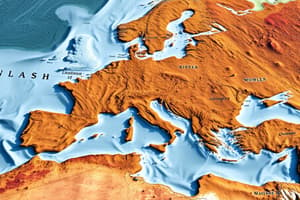Podcast
Questions and Answers
What does absolute location refer to?
What does absolute location refer to?
- The geographic coordinates of a place
- The actual space a place occupies on Earth's surface (correct)
- The historical significance of a location
- The cultural characteristics of a place
What is acculturation?
What is acculturation?
The change that occurs within a culture when it adopts a practice from another culture
What are agglomeration effects?
What are agglomeration effects?
The cost advantages for an individual company gained by locating near similar industries or companies
What is agribusiness?
What is agribusiness?
Define agricultural density.
Define agricultural density.
What is an alliance in a geopolitical context?
What is an alliance in a geopolitical context?
What does animism encompass?
What does animism encompass?
What is an antecedent boundary?
What is an antecedent boundary?
What does an artifact represent?
What does an artifact represent?
What is assimilation?
What is assimilation?
What is the backwash effect?
What is the backwash effect?
What does the basic sector of an economy refer to?
What does the basic sector of an economy refer to?
Define the bid-rent curve.
Define the bid-rent curve.
What is biotechnology?
What is biotechnology?
What constitutes the built environment?
What constitutes the built environment?
What is carrying capacity?
What is carrying capacity?
What is a central business district (CBD)?
What is a central business district (CBD)?
What is central place theory?
What is central place theory?
What does centrifugal force imply in a national context?
What does centrifugal force imply in a national context?
What is centripetal force?
What is centripetal force?
What is chain migration?
What is chain migration?
What does channelized migration refer to?
What does channelized migration refer to?
What is a charter group?
What is a charter group?
Define a compact state.
Define a compact state.
What is colonialism?
What is colonialism?
What does commodity chain refer to?
What does commodity chain refer to?
What does the concentric zone model illustrate?
What does the concentric zone model illustrate?
What is a confederation?
What is a confederation?
What does congregation refer to in a socio-cultural context?
What does congregation refer to in a socio-cultural context?
What is a consequent boundary?
What is a consequent boundary?
What is conservation agriculture?
What is conservation agriculture?
Flashcards are hidden until you start studying
Study Notes
Key Terms in AP Human Geography
-
Absolute location: The specific geographic coordinates of a place on Earth's surface.
-
Acculturation: Cultural change resulting from the adoption of practices from another culture.
-
Agglomeration effects: Cost benefits gained by businesses through proximity to similar industries, leading to external economies.
-
Agribusiness: Large-scale commercial agriculture operated by corporations, focusing on profitability across production stages.
-
Agricultural density: The ratio of the rural population to the available agricultural land.
-
Alliance: A formal arrangement among nations for collective defense or trade purposes.
-
Animism: A belief system that ascribes spiritual essence to natural objects and phenomena.
-
Antecedent boundary: A border established before significant cultural development occurred in the region.
-
Artifact: Physical objects representing material culture, significant for historical understanding.
-
Assimilation: The process where immigrants fully adopt the customs and culture of the host society.
-
Backwash effect: Negative consequences for a region as resources (labor, capital) are drawn towards a more prosperous area.
-
Basic sector: Industries producing goods and services primarily for external markets, outside the urban area.
-
Bid-rent curve: A model illustrating how land value varies in concentric zones from the city center based on demand.
-
Biotechnology: The use of scientific methods to alter and enhance the properties of biological entities like crops and livestock.
-
Built environment: The human-made surroundings that provide the setting for human activity.
-
Carrying capacity: The maximum population an environment can sustain indefinitely without degrading.
-
Central business district (CBD): The primary commercial area at the core of older cities.
-
Central place theory: Proposed by Walter Christaller, explaining urban settlements' formation based on economic functions and the need for goods and services.
-
Centrifugal force: Factors that lead to division and conflict within a country, such as ethnic or religious disparities.
-
Centripetal force: Elements that unify a nation, such as shared culture and leadership.
-
Chain migration: Subsequent waves of migrants moving to areas their relatives or friends previously settled.
-
Channelized migration: Non-familial and repetitive migration patterns, exemplified by older adults relocating to warmer regions.
-
Charter group: The initial settlers who establish a distinct culture and society in a new area.
-
Compact state: A state with a nearly round shape, which can facilitate easier governance and infrastructure.
-
Colonialism: The practice of a country exerting control over foreign territories for political and economic domination.
-
Commodity chain: A sequence of processes involved in the production and distribution of a product.
-
Concentric zone model: A framework for urban land use depicting the social stratification and growth of cities through concentric circles.
-
Confederation: A union of states or regions created for mutual support while often retaining individual governance.
-
Congregation: The clustering of ethnic groups in specific urban areas to foster community support.
-
Consequent boundary: A boundary created based on pre-existing cultural or linguistic criteria.
-
Conservation agriculture: Farming practices aimed at increasing crop productivity while preserving environmental health.
Studying That Suits You
Use AI to generate personalized quizzes and flashcards to suit your learning preferences.




